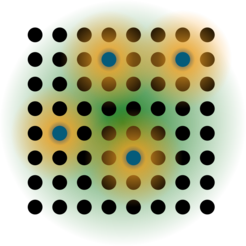Mimicking Quantum Chemistry: Analogue quantum simulation of pseudomolecules
Theorists develop a simplified experimental concept that could enable the first quantum simulations of chemistry.
The simulation of quantum chemical processes promises a lot of progress, such as the discovery of new chains of reactions, new synthetic materials or pharmaceuticals. But it is an enormous task, which known methods have failed to date. For classical supercomputers, the molecules are too complex, and for quantum simulations with cold atoms, the technological hurdles are still too high. In a new paper, theorists at the Max Planck Institute of Quantum Optics (MPQ) have now developed a simplified method that puts such simulations within reach – but at a price: The simulated models are only an approximation to the chemical reality and have different properties. Therefore, they don’t allow precise predictions but offer a new and instructive approach to quantum chemistry and to the experimental challenges of quantum simulations of this kind.

Quantum chemistry is a branch of theoretical chemistry that attempts to calculate chemical properties of molecules and their reactions using quantum mechanical atomic models. A successful calculation could replace many experimental experiments and accelerate progress in chemistry. But both conventional and quantum mechanical methods have so far failed to fully achieve that goal: supercomputers fail to capture complex quantum states exactly, and quantum simulations with cold atoms, although conceptually known, are still held back by their technological difficulties.
In existing platforms, such as those being developed in Immanuel Bloch's group at MPQ, ultracold atoms in optical lattices can jump from one site to another and interact with each other. This is used to perform quantum simulations of strongly correlated electrons. Most such experiments work with contact interactions and therefore require high densities of about one atom per lattice site to observe the effects of strong interactions. Electrons in molecules, however, are – relative to their size – usually far apart, because they are negatively charged and thus repel even over larger distances.
Thus, for cold atoms in optical lattices to behave like electrons in the molecules strong ranged interaction must be implemented. One way to create such long-range interactions between cold atoms is “Rydberg Dressing”. Using a laser, atoms are brought into a state in which the outmost electron (the valence electron) is in a superposition of ground state and an almost-ionized state. In the almost-ionized state, the electron is far away from the nucleus, causing a fluctuating dipole that generates long-range interactions of the atoms.
Rydberg dressing and optical lattices combined
Theorists at the Max Planck Institute of Quantum Optics have now developed a new approach that combines Rydberg dressing and optical lattices to perform analogue simulations on a simplified model of quantum chemistry. In their proposal, cold atoms play the role of electrons moving in a discrete space (the optical lattice) and repel each other through Rydberg dressing as if they were negatively charged. Simultaneously, a potential is imposed that simulates the attraction to the atomic cores. The concept explicitly refrains from full agreement with quantum chemistry in order to greatly simplify the experimental implementation.
Though different, the alternative version of quantum chemistry that can be simulated in this proposal still contains many of the most important physical phenomena of real quantum chemistry. The authors’ proposal therefore provides a useful testbed to start exploring analog quantum chemistry simulations and assess the experimental requirements and challenges. The scientists support their results with numerical simulations of experiments to produce helium or molecular hydrogen, to measure the bond length in molecular hydrogen, or perform hydrogen spectroscopy using realistic parameters.
The protocol’s simplicity allows it to be implemented in current state-of-the-art quantum simulation experiments which could pave the way for the first experimental exploration of quantum chemistry using analogue quantum simulations – and thus even accelerate the discovery of new reaction chains, synthetic substances, catalysts or medications in the future.












